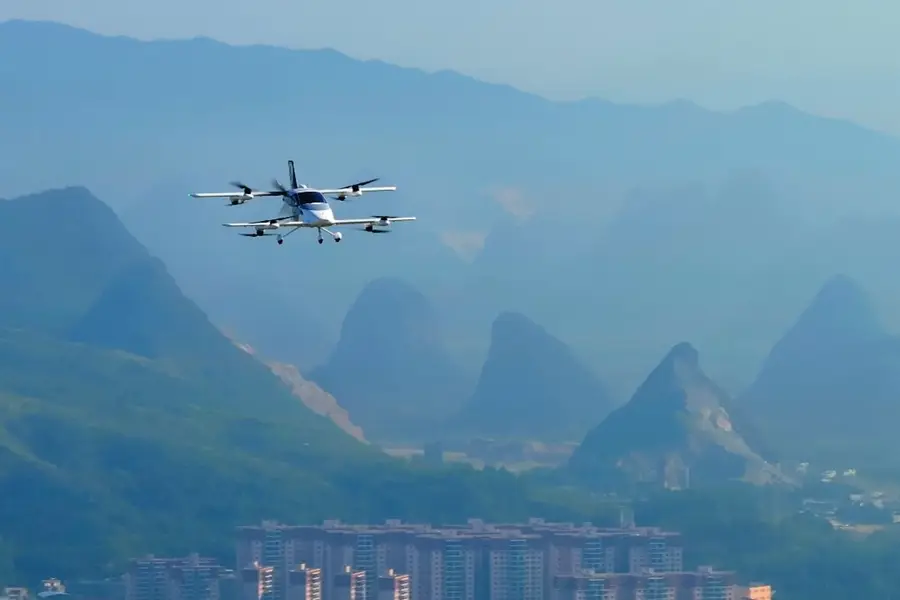EHang tries to break from holding pattern with new longer-range aircraft

The electric vertical take-off and landing aircraft maker unveiled its second major model with a range of up to 200 kilometers, complementing its original model for short distances
Key Takeaways:
- EHang has launched a second major model, the VT35, whose 200-kilometer range complements the much shorter 30 kilometers for its original EH216-S
- The company has found a major benefactor in the municipal government of Hefei, capital of Anhui province, which has pledged 500 million yuan in support
By Doug Young
Electric vertical take-off and landing (eVTOL) aircraft maker EHang Holdings Ltd. (EH.US) appears to be in a holding pattern these days. Its stock has been cruising in a broad but still relatively well-defined range since its flagship product notched a major milestone two years ago by receiving an airworthiness certificate from China’s aviation regulator.
In an attempt to bring some lift back to its shares, the company has begun hyping its next major new product, a longer-range eVTOL that can fly up to 200 kilometers, to complement its original short-range EH216-S model with a range of about 30 kilometers. In August it announced a major new plan to build a production base for the new model, the VT35, in Hefei, capital of East China’s Anhui province.
Now, the company has tried to wow investors with the official launch of the VT35 on Monday in Hefei. Notably, the event was described as an “unveiling ceremony,” suggesting that no one got to see the VT35 actually fly. Several photos of the eVTOL in the air accompanying a press release are clearly from South China’s scenic Guangxi region, which also suggests the plane has made some limited flights but may not be quite ready for the kind of audience that attends this kind of big news event.
The event was attended by high officials from the Hefei city government, as well as local automaker JAC Group and a low-altitude air official from China’s aviation regulator. All three of those are significant, since Hefei has recently become a major EHang benefactor, and JAC will be the main producer of the VT35. The regulator’s presence reflects China’s frequent comments that it wants to develop its low-altitude air economy, even though those plans have yet to gain much traction.
Investors were somewhat impressed with the news, bidding up EHang’s U.S.-listed shares by 4.8% on Monday after the announcement. But this type of stock gain, as well as similar-sized single-day declines, have become somewhat regular for this company over the last two years since it became one of the world’s first in its class to obtain a flightworthiness certificate from a major aviation regulator.
That would seem to indicate the stock has become popular among day traders but has yet to find an audience from the kinds of longer-term investors who could really give the shares some lift. Its latest close of $18.04 is roughly in the middle of the $10 to $26 range where its American depositary shares (ADS) have spent most of the last two years.
EHang didn’t help its case in August when it sharply lowered its revenue guidance for 2025, dropping its outlook to 500 million yuan ($70 million) from a previous 900 million yuan. It only gave some vague explanation, saying it was moderating its pace of deliveries “to optimize our commercial operation processes and manage risks effectively, ensuring that our demonstration flights are high quality and scalable.”
Intercity travel
All of this shows that developing something as sophisticated as an electric pilotless small plane for commercial use is a long endeavor that’s easy to hype but highly prone to setbacks. None of that is unexpected, but it does require a company like EHang to constantly look for new developments to keep investors excited.
The latest news looks designed to do just that, containing quite a bit of detail on the new VT35, whose longer range makes it suitable for intercity, cross-mountain and cross-sea travel, according to the launch announcement. The model carries an initial price of 6.5 million yuan, or just under $1 million. China’s aviation regulator accepted EHang’s flight certification application for the model in March, officially starting the airworthiness process.
EHang hasn’t given any indication of when the plane, which can seat two people, might get certified. But such a milestone is probably at least a few years away, though EHang’s experience with its first model could help to expedite things somewhat.
In what should come as no surprise, EHang added it has already received orders for the plane from an entity connected to the Hefei municipal government. Hefei has become one of EHang’s biggest fans since February, when the company first announced plans to build an eVTOL production base in the city with local auto champion JAC and Guoxin Holdings, a local investment vehicle.
In August, EHang announced that base would be focused on production of the new longer-range model, with total investment of 1 billion yuan. Significantly, it added the Hefei government would provide an additional 500 million yuan in “comprehensive support” that could include aircraft orders, investments and other forms of cooperation.
All of that comes as EHang’s business is gradually taking off, though still at a slower rate than many longer-term investors would probably like to see. The company’s revenue rose 44% year-on-year to 147 million yuan in the second quarter, as it delivered 68 of its EH216 models. But enterprises accounted for only 13 of the parties receiving deliveries, showing the company is still heavily reliant on government support. That’s not necessarily a bad thing, as EHang points out a growing number of applications for its eVTOLs are coming from government-based areas, such as emergency and smart city management, firefighting, rescue, logistics and surveying.
The company’s gross margins are also quite healthy and steady at around 62%, and it’s even profitable on an adjusted basis, which excludes employee share-based compensation. It’s relatively cash-rich as well – which hasn’t always been the case – with 1.13 billion yuan in its coffers at the end of June.
In terms of valuation, EHang currently trades at a price-to-book (P/B) ratio of 9.8, in between the 17 for Joby Aviation (JOBY.US) and 3.91 for Archer Aviation (ACHR.US), which both have yet to record revenue as they work towards their own flight certificates. EHang appears to be at the head of the global eVTOL pack based on its receipt of a flight certificate from China. But its sharp downward revenue forecast suggests some turbulence still lies ahead for the company, even as it continues making steady advances with developments like the launch of the new longer-range VT35.
To subscribe to Bamboo Works free weekly newsletter, click here




